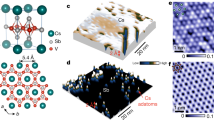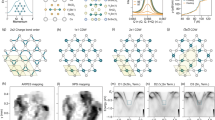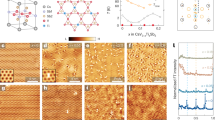Abstract
A nematic phase breaks the point-group symmetry of the crystal lattice and is known to emerge in correlated materials. Here we report the observation of an intra-unit-cell nematic order and associated Fermi surface deformation in the kagome metal ScV6Sn6. Using scanning tunnelling microscopy and scanning tunnelling spectroscopy, we reveal a stripe-like nematic order breaking the crystal rotational symmetry within the kagome lattice itself. Moreover, we identify a set of Van Hove singularities adhering to the kagome-layer electrons, which appear along one direction of the Brillouin zone and are annihilated along other high-symmetry directions, revealing rotational symmetry breaking. Via detailed spectroscopic maps, we further observe an elliptical deformation of the Fermi surface, which provides direct evidence for an electronically mediated nematic order. Our work not only bridges the gap between electronic nematicity and kagome physics but also sheds light on the potential mechanism for realizing symmetry-broken phases in correlated electron systems.
This is a preview of subscription content, access via your institution
Access options
Access Nature and 54 other Nature Portfolio journals
Get Nature+, our best-value online-access subscription
27,99 € / 30 days
cancel any time
Subscribe to this journal
Receive 12 print issues and online access
269,00 € per year
only 22,42 € per issue
Buy this article
- Purchase on SpringerLink
- Instant access to full article PDF
Prices may be subject to local taxes which are calculated during checkout





Similar content being viewed by others
Data availability
All data needed to evaluate the conclusions in the paper are present in the Article and its Supplementary Information. Additional data are available from the corresponding author upon reasonable request.
References
Baker, M. & Glashow, S. L. Spontaneous breakdown of elementary particle symmetries. Phys. Rev. 128, 2462 (1962).
Anderson, P. W. More is different: broken symmetry and the nature of the hierarchical structure of science. Science 177, 393–396 (1972).
Leggett, A. J. & Sols, F. On the concept of spontaneously broken gauge symmetry in condensed matter physics. Found. Phys. 21, 353–364 (1991).
Vojta, M. Lattice symmetry breaking in cuprate superconductors: stripes, nematics, and superconductivity. Adv. Phys. 58, 699–820 (2009).
Tsuei, C. C. & Kirtley, J. R. Pairing symmetry in cuprate superconductors. Rev. Mod. Phys. 72, 969 (2000).
Kivelson, S. A., Fradkin, E. & Emery, V. J. Electronic liquid-crystal phases of a doped Mott insulator. Nature 393, 550–553 (1998).
Fradkin, E., Kivelson, S., Lawler, M. J., Eisenstein, J. P. & Mackenzie, A. P. Nematic Fermi fluids in condensed matter physics. Annu. Rev. Condens. Matter Phys. 1, 153–178 (2010).
Böhmer, A. E. et al. Nematicity and nematic fluctuations in iron-based superconductors. Nat. Phys. 18, 1412–1419 (2022).
Fernandes, R., Chubukov, A. & Schmalian, J. What drives nematic order in iron-based superconductors? Nat. Phys. 10, 97–104 (2014).
Nie, L. et al. Charge-density-wave-driven electronic nematicity in a kagome superconductor. Nature 604, 59–64 (2022).
Lawler, M. et al. Intra-unit-cell electronic nematicity of the high-Tc copper-oxide pseudogap states. Nature 466, 347–351 (2010).
Fischer, O., Kugler, M., Maggio-Aprile, I., Berthod, C. & Renner, C. Scanning tunneling spectroscopy of high temperature superconductors. Rev. Mod. Phys. 79, 353 (2007).
Landau, L. D. On the theory of the Fermi liquid. Sov. Phys. JETP 35, 1–70 (1959).
Pomeranchuk, I. J. On the stability of a Fermi liquid. Sov. Phys. JETP 8, 361 (1958).
Abrikosov, A. A. et al. Methods of Quantum Field Theory in Statistical Physics (Dover, 1975).
Kiesel, M. L., Platt, C. & Thomale, R. Unconventional Fermi surface instabilities in the kagome Hubbard model. Phys. Rev. Lett. 110, 126405 (2013).
Zhang, P. et al. A precise method for visualizing dispersive features in image plots. Rev. Sci. Instrum. 82, 043712 (2011).
Fradkin, E., Kivelson, S. A. & Tranquada, J. M. Colloquium: theory of intertwined orders in high temperature superconductors. Rev. Mod. Phys. 87, 457–482 (2015).
Lee, K. et al. Pomeranchuk instability of composite Fermi liquids. Phys. Rev. Lett. 121, 147601 (2018).
Zhao, H. et al. Cascade of correlated electron states in the kagome superconductor CsV3Sb5. Nature 599, 216–221 (2021).
Chen, H. et al. Roton pair density wave in a strong coupling kagome superconductor. Nature 599, 222–228 (2021).
Yin, J. X., Lian, B. & Hasan, M. Z. Topological kagome magnets and superconductors. Nature 612, 647–657 (2022).
Ortiz, B. R. et al. New kagome prototype materials: discovery of KV3Sb5, RbV3Sb5, and CsV3Sb5. Phys. Rev. Mater. 3, 094407 (2019).
Jiang, Y.-X. et al. Unconventional chiral charge order in kagome superconductor KV3Sb5. Nat. Mater. 20, 1353–1357 (2021).
Park, T., Ye, M. & Balents, L. Electronic instabilities of kagome metals: saddle points and Landau theory. Phys. Rev. B 104, 035142 (2021).
Denner, M. M., Thomale, R. & Neupert, T. Analysis of charge order in the kagome metal AV3Sb5 (A = K, Rb, Cs). Phys. Rev. Lett. 127, 217601 (2021).
Kang, M. et al. Twofold Van Hove singularity and origin of charge order in topological kagome superconductor CsV3Sb5. Nat. Phys. 18, 301–308 (2022).
Li, H., Cheng, S. & Ortiz, B. R. et al. Electronic nematicity without charge density waves in titanium-based kagome metal. Nat. Phys. 19, 1591–1598 (2023).
Arachchige, H. W. S. et al. Charge density wave in kagome lattice intermetallic ScV6Sn6. Phys. Rev. Lett. 129, 216402 (2022).
Tan, H. & Yan, B. Abundant lattice instability in kagome metal ScV6Sn6. Phys. Rev. Lett. 130, 266402 (2023).
Zhang, X. et al. Destabilization of the charge density wave and the absence of superconductivity in ScV6Sn6 under high pressures up to 11 GPa. Materials 15, 7372 (2022).
Tuniz, M. et al. Dynamics and resilience of the unconventional charge density wave in ScV6Sn6 bilayer kagome metal. Commun. Mater. 4, 103 (2023).
Hu, T. et al. Optical spectroscopy and band structure calculations of the structural phase transition in the vanadium-based kagome metal ScV6Sn6. Phys. Rev. B 107, 165119 (2023).
Kang, S. H. et al. Emergence of a new band and the Lifshitz transition in kagome metal ScV6Sn6 with charge density wave. Preprint at https://arxiv.org/abs/2302.14041 (2023).
Cheng, S. et al. Nanoscale visualization and spectral fingerprints of the charge order in ScV6Sn6 distinct from other kagome metals. NPJ Quantum Mater 9, 14 (2024).
Lee, S. et al. Nature of charge density wave in kagome metal ScV6Sn6. NPJ Quantum Mater 9, 15 (2024).
Hu, Y. et al. Phonon promoted charge density wave in topological kagome metal ScV6Sn6. Nat. Commun. 15, 1658 (2024).
Korshunov, A. et al. Softening of a flat phonon mode in the kagome ScV6Sn6. Nat. Commun. 14, 6646 (2023).
Guguchia, Z. et al. Hidden magnetism uncovered in charge ordered bilayer kagome material ScV6Sn6. Nat. Commun. 14, 7796 (2023).
Hu, H. et al. Kagome materials I: SG 191, ScV6Sn6. Flat phonon soft modes and unconventional CDW formation: microscopic and effective theory. Preprint at https://arxiv.org/abs/2305.15469 (2023).
Yin, J. X. et al. Quantum-limit Chern topological magnetism in TbMn6Sn6. Nature 583, 533–536 (2020).
Li, H. et al. Manipulation of Dirac band curvature and momentum-dependent g factor in a kagome magnet. Nat. Phys. 18, 644–649 (2022).
Machida, T. et al. Superconductivity near the saddle point in the two-dimensional Rashba system Si(111)–√3 × √3–(Tl, Pb). Phys. Rev. B 105, 064507 (2022).
Zhu, Z. et al. Quasiparticle interference and nonsymmorphic effect on a floating band surface state of ZrSiSe. Nat. Commun. 9, 4153 (2018).
Grothe, S. Quantifying many-body effects by high-resolution Fourier transform scanning tunneling spectroscopy. Phys. Rev. Lett. 111, 246804 (2013).
Kiesel, M. L. & Thomale, R. Sublattice interference in the kagome Hubbard model. Phys. Rev. B 86, 121105R (2012).
Wang, W.-S., Li, Z.-Z., Xiang, Y.-Y. & Wang, Q.-H. Competing electronic orders on kagome lattices at Van Hove filling. Phys. Rev. B 87, 115135 (2013).
Butler, C. J. et al. Correlation-driven electronic nematicity in the Dirac semimetal BaNiS2. Proc. Natl Acad. Sci. USA 119, e2212730119 (2022).
Scammell, H. D., Ingham, J., Li, T. & Sushkov, O. P. Chiral excitonic order from twofold Van Hove singularities in kagome metals. Nat. Commun. 14, 605 (2023).
Guo, C. et al. Correlated order at the tipping point in the kagome metal CsV3Sb5. Nat. Phys. 20, 579–584 (2024).
Perdew, J. P., Burke, K. & Ernzerhof, M. Generalized gradient approximation made simple. Phys. Rev. Lett. 77, 3865 (1996).
Kresse, G. & Furthmüller, J. Efficient iterative schemes for ab initio total-energy calculations using a plane-wave basis set. Phys. Rev. B 54, 11169 (1996).
Blöchl, P. E. Projector augmented-wave method. Phys. Rev. B 50, 17953 (1994).
Acknowledgements
The M.Z.H. group acknowledges primary support from the US Department of Energy, Office of Science, National Quantum Information Science Research Centers, Quantum Science Center (at Oak Ridge National Laboratory) and Princeton University; scanning tunneling microscopy instrumentation support from the Gordon and Betty Moore Foundation (GBMF9461) and support with theory work; and support from the US Department of Energy under the Basic Energy Sciences program (grant no. DOE/BES DE-FG-02-05ER46200) for the theory and sample characterization work, including photoemission spectroscopy. Work at Nanyang Technological University was supported by the National Research Foundation, Singapore, under its Fellowship Award (NRF-NRFF13-2021-0010), the Agency for Science, Technology and Research (A*STAR) under its Manufacturing, Trade and Connectivity Individual Research Grant (grant no. M23M6c0100), the Singapore Ministry of Education AcRF Tier 2 grant (MOE-T2EP50222-0014) and the Nanyang Assistant Professorship grant (NTU-SUG). The computational work at Nanyang Technological University for this article was partially performed on resources of the National Supercomputing Centre, Singapore (https://www.nscc.sg). T.N., M.M.D. and S.Z. were supported by the European Research Council under the European Union’s Horizon 2020 research and innovation programme (ERC-StG-Neupert-757867-PARATOP). S.Z. was also supported by the UZH Postdoc Grant. R.T. was supported by the Deutsche Forschungsgemeinschaft (German Research Foundation) through Project-ID 258499086-SFB 1170 and the Wurzburg-Dresden Cluster of Excellence on Complexity and Topology in Quantum Matter–ct.qmat Project-ID 390858490-EXC 2147. Y.G. acknowledges the Double First-Class Initiative Fund of ShanghaiTech University. W.X. acknowledges the research fund from the State Key Laboratory of Surface Physics and Department of Physics, Fudan University (grant no. KF2022_13). Y.P. is grateful for financial support from the National Natural Science Foundation of China (grant no. 12374143).
Author information
Authors and Affiliations
Contributions
Y.-X.J. and M.S.H. conducted the STM experiments in consultation with M.Z.H. W.X. and Y.G. synthesized the samples. Q.Q., X.Z. and Y.P. performed the X-ray measurements. M.M.D., J.I., S.Z., G.C., R.T. and T.N. carried out the theoretical analysis in consultation with Y.-X.J. and M.Z.H. S.S., H.C. and G.C. conducted the first-principles calculations. J.-X.Y., Z.-J.C., X.P.Y., M.L., Q.Z. and T.A.C. contributed to the calibration of the measurements. Y.-X.J. and M.Z.H. performed the data analysis and figure development, and wrote the paper with contributions from all authors. M.Z.H. supervised the project. All authors discussed the results, interpretation and conclusion.
Corresponding authors
Ethics declarations
Competing interests
The authors declare no competing interests.
Peer review
Peer review information
Nature Materials thanks the anonymous reviewers for their contribution to the peer review of this work.
Additional information
Publisher’s note Springer Nature remains neutral with regard to jurisdictional claims in published maps and institutional affiliations.
Supplementary information
Supplementary Information
Supplementary Discussions I–IV and Figs. 1–17.
Rights and permissions
Springer Nature or its licensor (e.g. a society or other partner) holds exclusive rights to this article under a publishing agreement with the author(s) or other rightsholder(s); author self-archiving of the accepted manuscript version of this article is solely governed by the terms of such publishing agreement and applicable law.
About this article
Cite this article
Jiang, YX., Shao, S., Xia, W. et al. Van Hove annihilation and nematic instability on a kagome lattice. Nat. Mater. 23, 1214–1221 (2024). https://doi.org/10.1038/s41563-024-01914-z
Received:
Accepted:
Published:
Issue Date:
DOI: https://doi.org/10.1038/s41563-024-01914-z



